#TUFTS???
Explore tagged Tumblr posts
Text

Just made this, does this make sense to anyone else?
#jax#tadc jax#the amazing digital circus jax#jax fanart#tadc#tadc fanart#the amazing digital circus#as a furry artist I am legally obligated to add excessive fur tufts
4K notes
·
View notes
Text
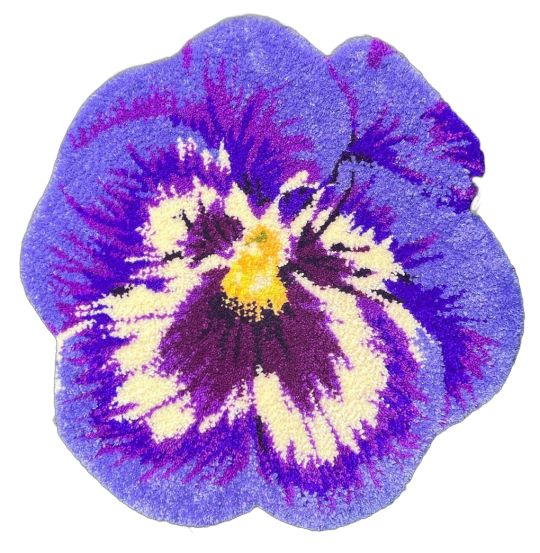
purple pansy tufted rug by PunchiesRugsArt [for sale!]
3K notes
·
View notes
Text

a little tufted titmouse out trick-or-treating! <3
#my art#digital art#artists on tumblr#art#animal art#birds#tufted titmouse#bird art#Halloween#Halloween art#cute animal art
9K notes
·
View notes
Text
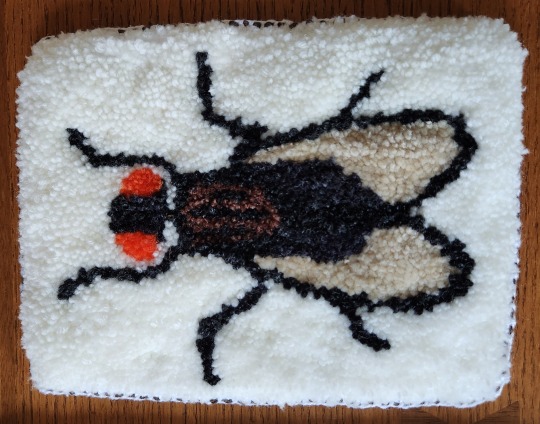
"little schemer", hand-punched, 2023
7.5" x 5.5"
#original art#rug punching#rug tufting#handcrafted#diy#handmade#fly#insect#art#needlework#needlecraft#bug#bugs#insects
7K notes
·
View notes
Text

learned something about myself lately
#i dont think its even the fact almost all my characters are somewhat beasts in one way or another. i just#really like tails and wish i had one myself#and then my oc designs are a little tame theyre mostly human shaped with animal features. but they always have tails#my eyes have recently been opened to the appeal of long whiplike unicorn tails.. so flowy and curly#something about the tuft at the end being long and swirly just does something for me..#maybe it would make sense to change auggies tail shape so it looks like a meteor. her design is mainly pink with hot pink accent#so it would be cool to use that and orange to make it look like a fire meteor.. maybe itll help complement the blue/green in her design#head full of ocs today so expect a ramble later#if i had a tail i think it would be long with a kink. so it kind of folds over once but not in a curl#when it wags its kind of a swaying motion. i have thought about this a normal amount#yapping
9K notes
·
View notes
Text

koiranputket, kissankellot, leinikit, hiirenvirnat
#transl: cow parsley. bluebell. buttercup. tufted vetch#photography#finland#photographers on tumblr#nature#summer#flowers#ainakin näin luulen! en mikään kasvi-ekspertti ole#ihanat eläimennimet näillä kasveilla:)
2K notes
·
View notes
Text
specify which and bonus points if you say why!
#warrior cats#some i didnt add bc of space are like#cloud sky storm / wing flight / pool / berry#swirl#tuft#i tried to keep it to the most common ones vs like. idk -hound or -beetle#there will be a part two maybe w these ones i forgor next week or smthn
5K notes
·
View notes
Text
Hooking rugs that look like dogs
Here's how I do it:
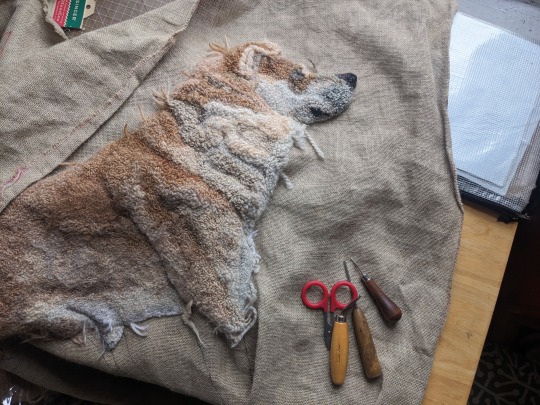
The process I use is called rug hooking (not latch hook or punch needle or tufting, though it is the forerunner of the latter two techniques). Rugs are hooked by pulling loops of fabric strips or yarn through the holes of a base fabric with a coarse open weave, like burlap, or linen, or rug warp. The loops are pulled through the fabric with a squat-handled hook whose business end is shaped like a crochet hook. There are no knots and the loops aren't sewed down in any way. The whole thing stays put just by the tension of all those loops packed together in the weave of the foundation fabric.
This isn't a true detailed tutorial but a walk-through of my particular process. The same information is on my web page, emilyoleary.com .
I hook with yarn, rather than with cut strips of wool fabric, which is what many rug hookers use. I can get a looser, more organic distribution of loops with yarn than I could with wool strips, which are hooked in neat lines.
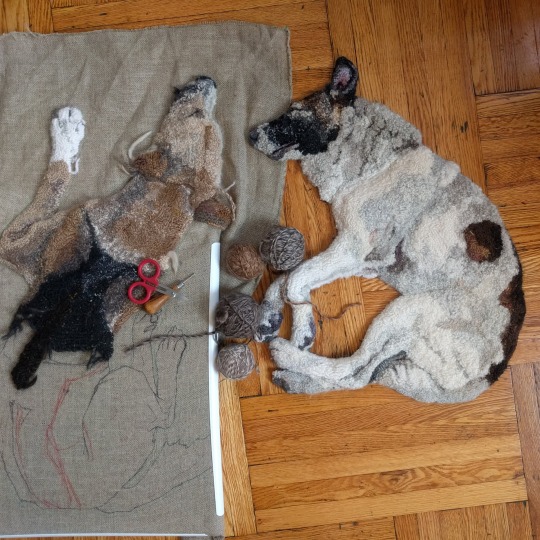
Mostly I use wool yarn. In terms of yarn weight, I can use DK, worsted, or Aran. If I'm using thicker yarn, I leave more holes un-hooked; if I'm using finer yarn, I hook more densely or double up lengths of it. I particularly like using single ply yarns (like Brown Sheep Lamb's Pride or Malabrigo Worsted). I don't keep count, but I think I usually use around two dozen types and colors of yarn per dog.
This is my yarn wall in my apartment. Mostly brown and gray yarn!

I start from a small drawing in my sketchbook, then I head to FedEx office to use a copy machine, blowing up the drawing repeatedly and experimenting with how big the dog rug should be.
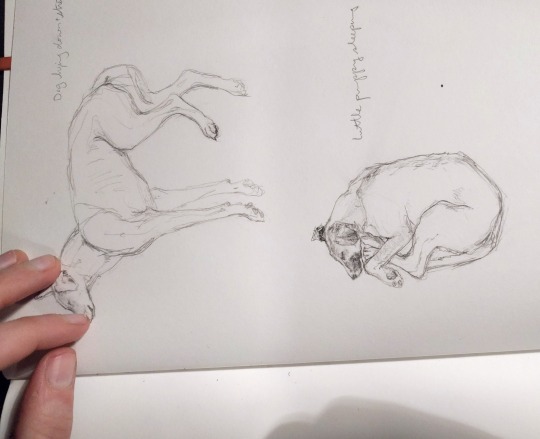
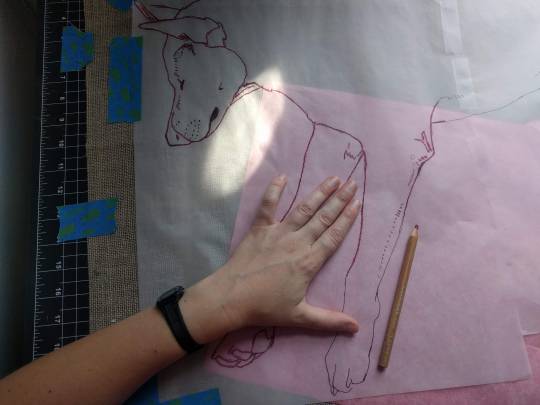
After transferring the image onto my linen, I immediately go over it with Sharpie, because the Saral is really difficult to see and really easy to rub off.
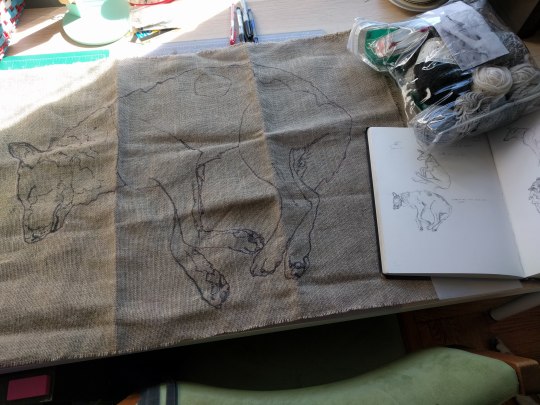
The rug is held taut by a PVC quilting frame that I set on my lap.
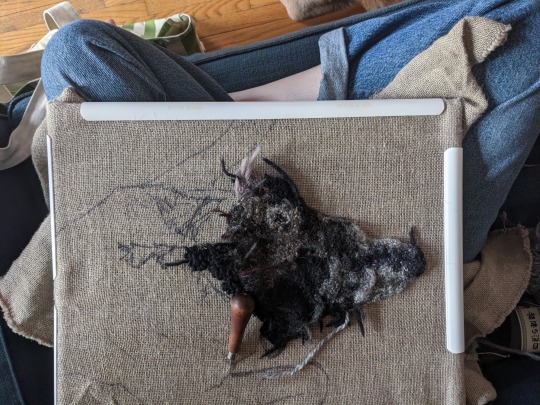
I push my hook down through the fabric with my right hand and my left hand stays below the fabric and guides the yarn while I pull it up and through with the hook. Not every hole in the fabric is hooked. Hooking every hole would make the rug too dense. I do hook pretty densely, though-- If you pick up one of my rugs you’ll see they have a slight curl to them, which is because they’re hooked pretty tight. I'm using all different weights and types of yarn, so it's a challenge to keep the overall tension even.
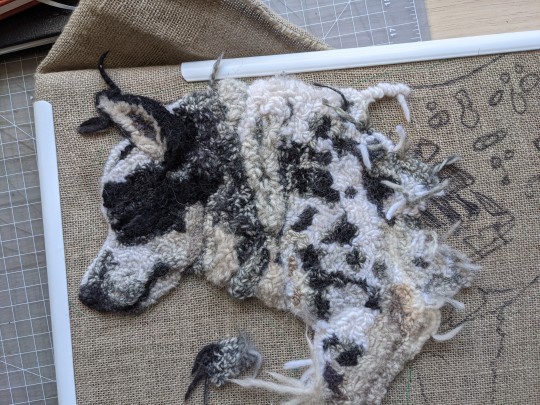
I hook my loops at varying heights to create a very low relief. Sometimes I trim the loops to make them fluffier or wispier or to shape a particular part. I look at a reference photo while I work and pull out and redo sections a lot.
My q-snap frame can accommodate the growing dog rug. I have extenders to make it bigger and I can clamp around my hooking.
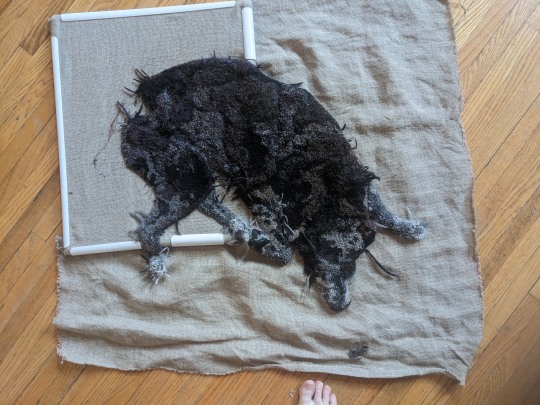
The back of a rug looks like lines of little stitches. The lines are little worm trails snaking around because lines of hooking are not supposed to cross over each other. It's important to start a new length of yarn rather than cross over a stitch you already made! I read this when I first started and took it to heart. It makes it much easier to undo and redo hooking if you have to (and I redo sections A Lot). It also keeps the back from getting too bulky and resulting in uneven wear on the back of a functional rug that gets floor use.

When I’m done hooking everything I turn the rug over and brush watered-down Sobo glue on the edges of the dog, making sure to get one or two of the outermost lines of hooking. I do a couple coats of this thinned out glue. I'm careful not to use so much that it seeps to the front of the rug. When the glue is dry I cut the rug out, but I don't cut so close that the loops don't have any linen to keep them in.

It generally takes me at least several months to finish one dog rug. My hooking frame and yarn bag are very portable (though bulky) so I can hook out and about at coffee shops or the library or a brewery if there's enough space and light.
Hooking in the wild makes me an ambassador for making things in general and rug hooking in particular. I answer people's questions and always emphasize how relatively easy it is to get started hooking. Sometimes I get anxious that other people will hook rugs that look like mine but better, but I think that working in a traditional medium means you should share your knowledge for the good of the craft.
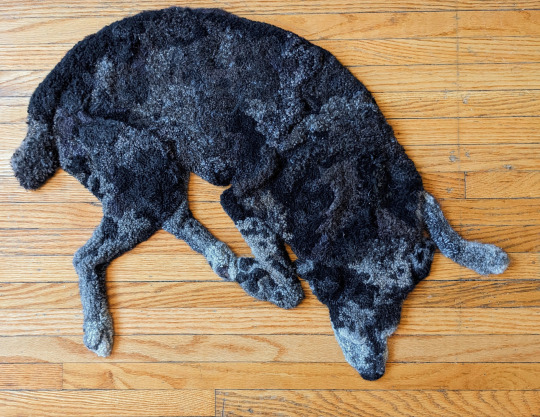
6K notes
·
View notes
Text


Lil' Lava and her big dragon-god girlfriend
#arknights#nian#lava#dlarts#i don't imagine nian being tall#but big enough to have a size difference between her and lava#nian's tail isn't like reed's#but i like the idea that the tuft turns to fire at will#been distracted by sui
1K notes
·
View notes
Text
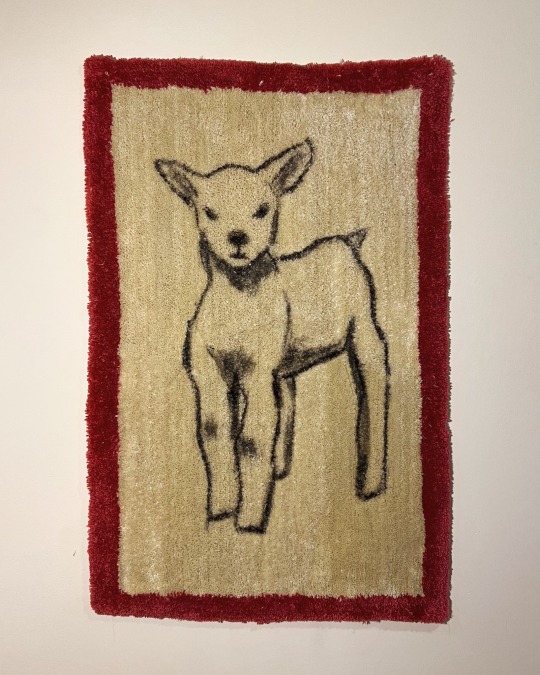
Acrylic on tufted rug
Mars Kneale
3K notes
·
View notes
Text

Haley Wood
11K notes
·
View notes
Text
From Gaza to the Student Protest Movement, with love:

Thank you 💜
#student protest#columbia university#palestine#palestinians#gaza#genocide#mass graves#mass murder#israeli apartheid#israeli occupation#idf terrorists#iof terrorism#war crimes#free palestine#free gaza#justice#university#yale#harvard#stanford#ucla#uc berkeley#tufts university#nyu#boston university#emerson college#students#usa#massachusetts institute of technology#rafah
1K notes
·
View notes
Text
Something i love about baby birds is how their mouths are just Like That
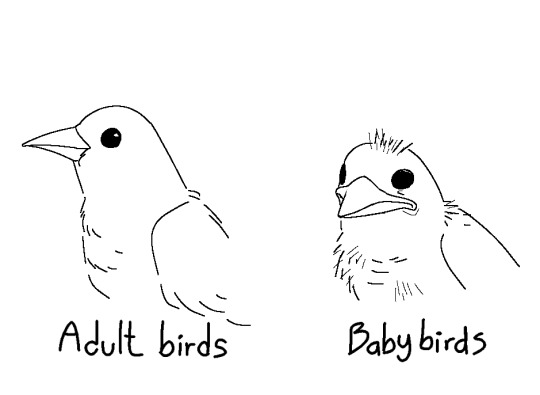
12K notes
·
View notes
Text

Blah! 🧛 Though it has “fangs,” the tufted deer (Elaphodus cephalophus) is no vampire. This herbivore inhabits high-altitude forests where it feeds on vegetation. Only males sport the signature tusks, which are used in combat over territory and to attract mates. These canines can grow up to 1 in (2.5 cm) long. This species can be found in parts of Asia. It’s crepuscular, meaning it’s typically most active at dawn and dusk.
Photo: Николай Усик, CC BY-SA 3.0, Wikimedia Commons
#science#nature#natural history#animals#fact of the day#did you know#deer#vampire#dracula#cool animals#fun facts#animal facts#tufted deer#spooky season#halloween
941 notes
·
View notes
Text

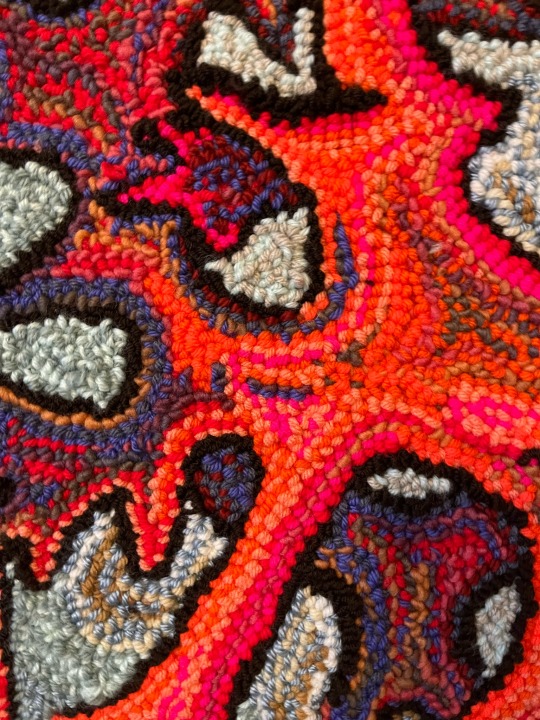
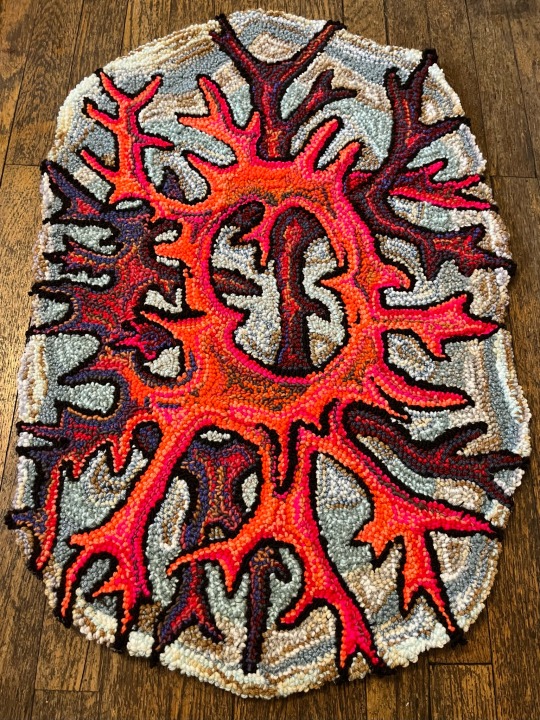
Radiozoa Floating In Cosmic Cesspool.
https://instagram.com/tom.puschautz
#artists on tumblr#trippy#grunge#scientific illustration#climate change#illustration#dark art#my art#punch needle#fibre arts#mixed media#tufting#yarn crafts#nature
2K notes
·
View notes
Text

The Englishwoman’s Bedroom, 1985
#vintage#interior design#home#vintage interior#architecture#home decor#style#1980s#bedroom#canopy bed#floral#chintz#tufted#chaise#armchair#trellis#wallpaper#traditional#cottage#English
755 notes
·
View notes